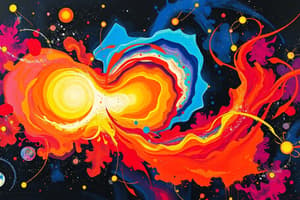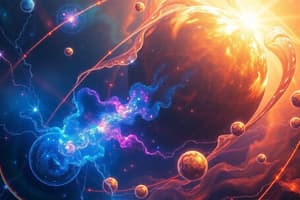Podcast
Questions and Answers
What did George Gamow contribute to the understanding of the universe?
What did George Gamow contribute to the understanding of the universe?
- He theorized the existence of dark energy.
- He refined Lemaitre's idea and postulated cosmic microwave background radiation. (correct)
- He developed the concept of gravitational waves.
- He proposed the existence of black holes in space.
What evidence supports the big bang theory?
What evidence supports the big bang theory?
- The relative abundance of elements, cosmic microwave background radiation, and the current expansion of the universe. (correct)
- The mapping of gravitational waves through space.
- The formation of planets from asteroids and comets.
- The discovery of dark matter in black holes.
What is believed to be the composition of the universe today?
What is believed to be the composition of the universe today?
- 50% radiation and 50% dark energy.
- 70% dark energy, 25% dark matter, and 5% radiation and visible matter. (correct)
- 100% visible matter only.
- 80% dark matter, 15% visible matter, and 5% dark energy.
Which process is responsible for the creation of heavier elements in the universe?
Which process is responsible for the creation of heavier elements in the universe?
What phenomenon occurs when heavy stars collapse and explode?
What phenomenon occurs when heavy stars collapse and explode?
How long ago is it believed that the big bang occurred?
How long ago is it believed that the big bang occurred?
What is the main component of the initial universe formed during the big bang?
What is the main component of the initial universe formed during the big bang?
What is the primary process that led to the formation of stars and their systems?
What is the primary process that led to the formation of stars and their systems?
What significant contribution did Edwin Hubble make to the understanding of the universe?
What significant contribution did Edwin Hubble make to the understanding of the universe?
Which theory posited that new matter is continuously created as galaxies expand?
Which theory posited that new matter is continuously created as galaxies expand?
Who proposed the idea of the universe beginning as a 'primeval atom'?
Who proposed the idea of the universe beginning as a 'primeval atom'?
Which astronomer showed that most nebulae are moving away from the Milky Way galaxy?
Which astronomer showed that most nebulae are moving away from the Milky Way galaxy?
What did Hermann Bondi and Thomas Gold argue about the universe in their steady-state theory?
What did Hermann Bondi and Thomas Gold argue about the universe in their steady-state theory?
What is the primary basis of Father George Lemaitre's theory?
What is the primary basis of Father George Lemaitre's theory?
What model replaced the geocentric model of the solar system?
What model replaced the geocentric model of the solar system?
How did William Huggins contribute to the understanding of the expanding universe?
How did William Huggins contribute to the understanding of the expanding universe?
What does the fate of the universe primarily depend on?
What does the fate of the universe primarily depend on?
Which hypothesis explains the origin and formation of the solar system?
Which hypothesis explains the origin and formation of the solar system?
Who proposed the nebular hypothesis that describes the formation of the solar system?
Who proposed the nebular hypothesis that describes the formation of the solar system?
What is a key aspect of the planetesimal hypothesis proposed by Chamberlin and Moulton?
What is a key aspect of the planetesimal hypothesis proposed by Chamberlin and Moulton?
According to recent data, what is the current trend observed in the expansion of the universe?
According to recent data, what is the current trend observed in the expansion of the universe?
What role does gravitational force play in the formation of celestial objects?
What role does gravitational force play in the formation of celestial objects?
Which of the following statements about the Chamberlin and Moulton theory is correct?
Which of the following statements about the Chamberlin and Moulton theory is correct?
What is one possible outcome for the universe as it continues to evolve?
What is one possible outcome for the universe as it continues to evolve?
Flashcards are hidden until you start studying
Study Notes
The Fate of the Universe
- The fate of the universe is a profound subject in astrophysics, hinging on the intricate interplay of mass, density, and the rate of expansion. This leads to three potential scenarios for the future of the universe: collapse, which would see the universe contracting back into a singularity; cessation of expansion, where the universe reaches a steady state and halts its growth; or continual expansion, in which the universe continues to expand indefinitely.
- Current astronomical observations, particularly those related to the cosmic microwave background radiation and galaxy movement, indicate that the universe is experiencing acceleration in its expansion. This suggests that a mysterious force, commonly referred to as dark energy, is dominating the universe's behavior, compelling it to expand at an increasing rate.
The Formation of the Solar System
- The widely accepted model for solar system formation is the proto-planet nebular hypothesis, which posits that our solar system formed from a large cloud of gas and dust approximately 5 billion years ago. This model explains the complex processes that led to the creation of planets, moons, asteroids, and other celestial bodies within our solar system.
- Pierre Simon Laplace, in the late 18th century, significantly contributed to this understanding by proposing the nebular hypothesis in 1796. He described how the material in the rotating disk around the young Sun gradually coalesced into clumps, which became the planetesimals. These building blocks then collided and merged to form larger bodies, ultimately leading to the creation of the planets we know today.
- Another important concept in understanding planetary formation is the planetesimal hypothesis, which was proposed by Thomas Chamberlin and Forest Moulton in 1905. This hypothesis suggested that materials ejected from the Sun formed protoplanets as they collided and combined over time. However, the planetesimal hypothesis has largely been dismissed in favor of the more comprehensive proto-planet hypothesis.
- The heliocentric model, proposed by Nicolaus Copernicus in the 16th century, revolutionized our understanding of the structure of the solar system. It positioned the Sun at the center, creating a fundamental shift from the geocentric perspective that placed Earth at the center of the universe. This model was later refined by the telescopic observations of Galileo Galilei and the laws of planetary motion articulated by Johannes Kepler, ultimately solidifying our understanding of orbital mechanics and the structure of the solar system.
The Route to the Big Bang
- In the early 20th century, Edwin Hubble made groundbreaking observations which revealed that distant galaxies and celestial objects are receding from us at increasing velocities. This significant finding indicated that the universe is not static, but rather expanding, thereby laying the groundwork for modern cosmology.
- The discovery of redshift by William Huggins in 1868 played a crucial role in this understanding. Redshift occurs when light from an object is shifted towards the red end of the spectrum as it moves away from an observer, allowing astronomers to measure the speed at which an object is receding. This evidence supports the notion of an expanding universe.
- Vesto Slipher, another key figure in this field, demonstrated that most nebulae observed within the Milky Way are similarly moving away from our galaxy, providing additional evidence for the expanding nature of the universe. Together, these observations solidified the concept of cosmic expansion, reshaping our understanding of the cosmos.
Theories of Cosmic Expansion
- The steady-state theory, proposed by Hermann Bondi and Thomas Gold in 1948, put forward the idea that the universe is eternal and unchanging on a grand scale. According to this theory, matter is continuously created as the universe expands, rendering it in a constant state despite its growth. However, advancements in observational cosmology—such as the discovery of cosmic background radiation—led to the eventual dis
Studying That Suits You
Use AI to generate personalized quizzes and flashcards to suit your learning preferences.




